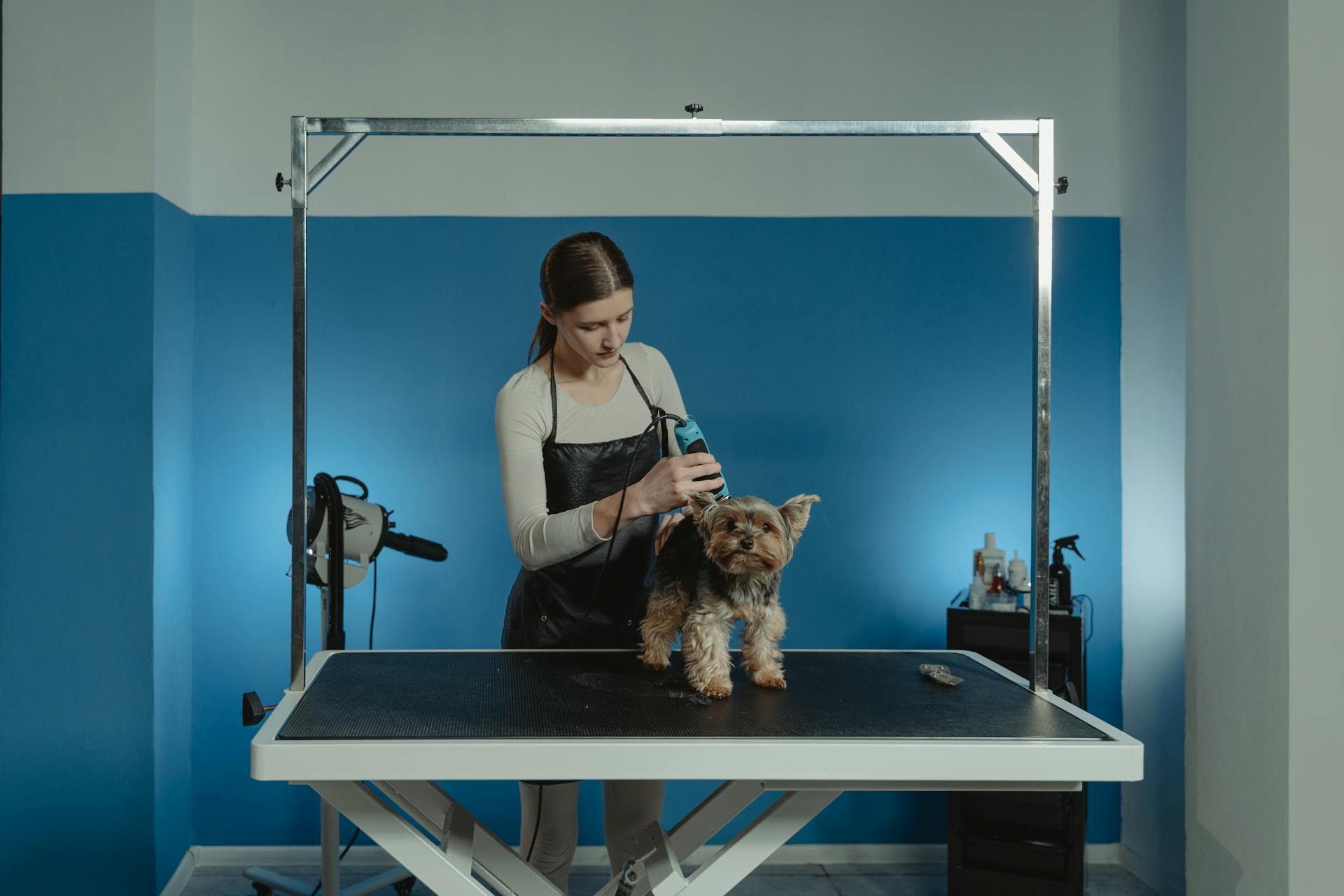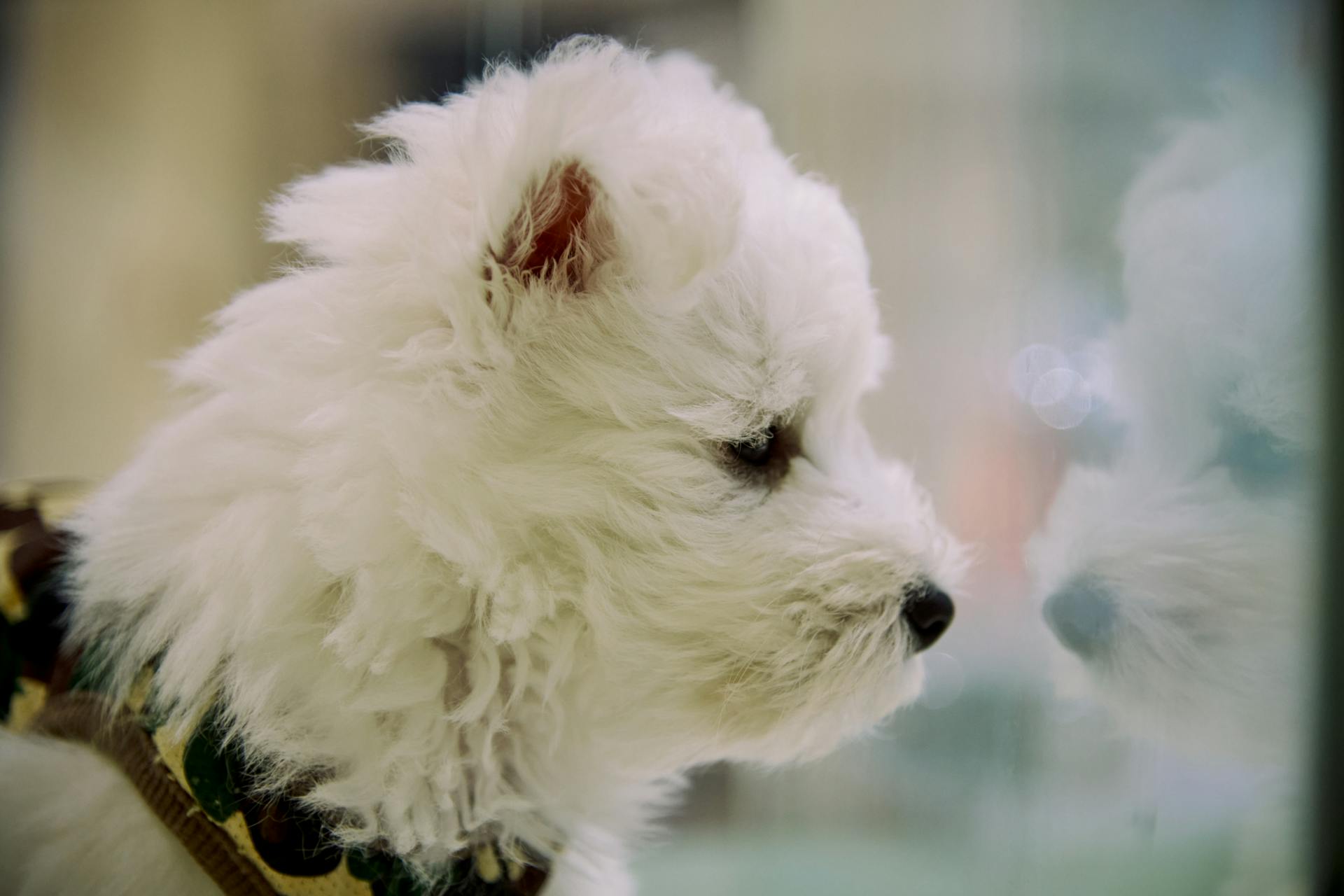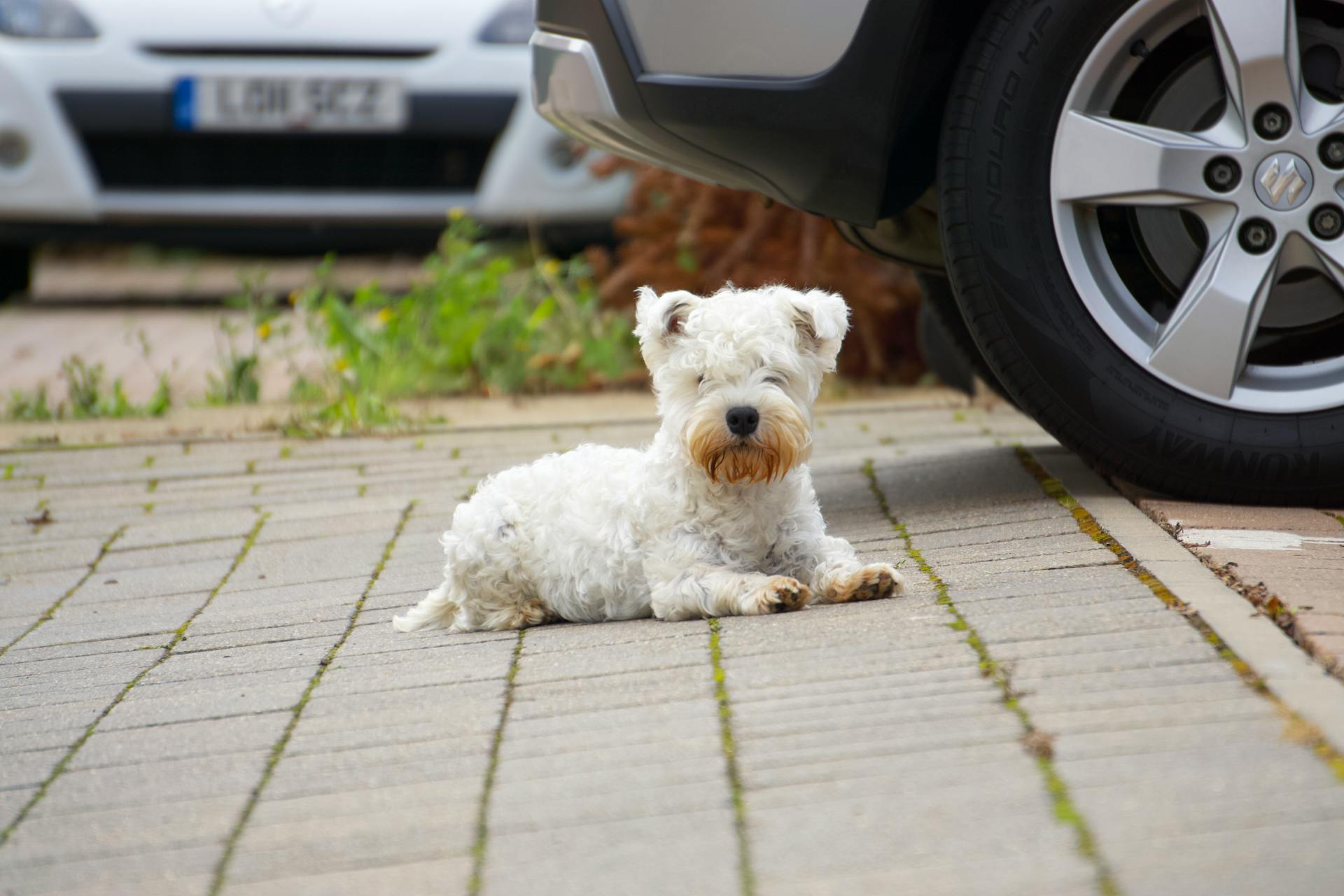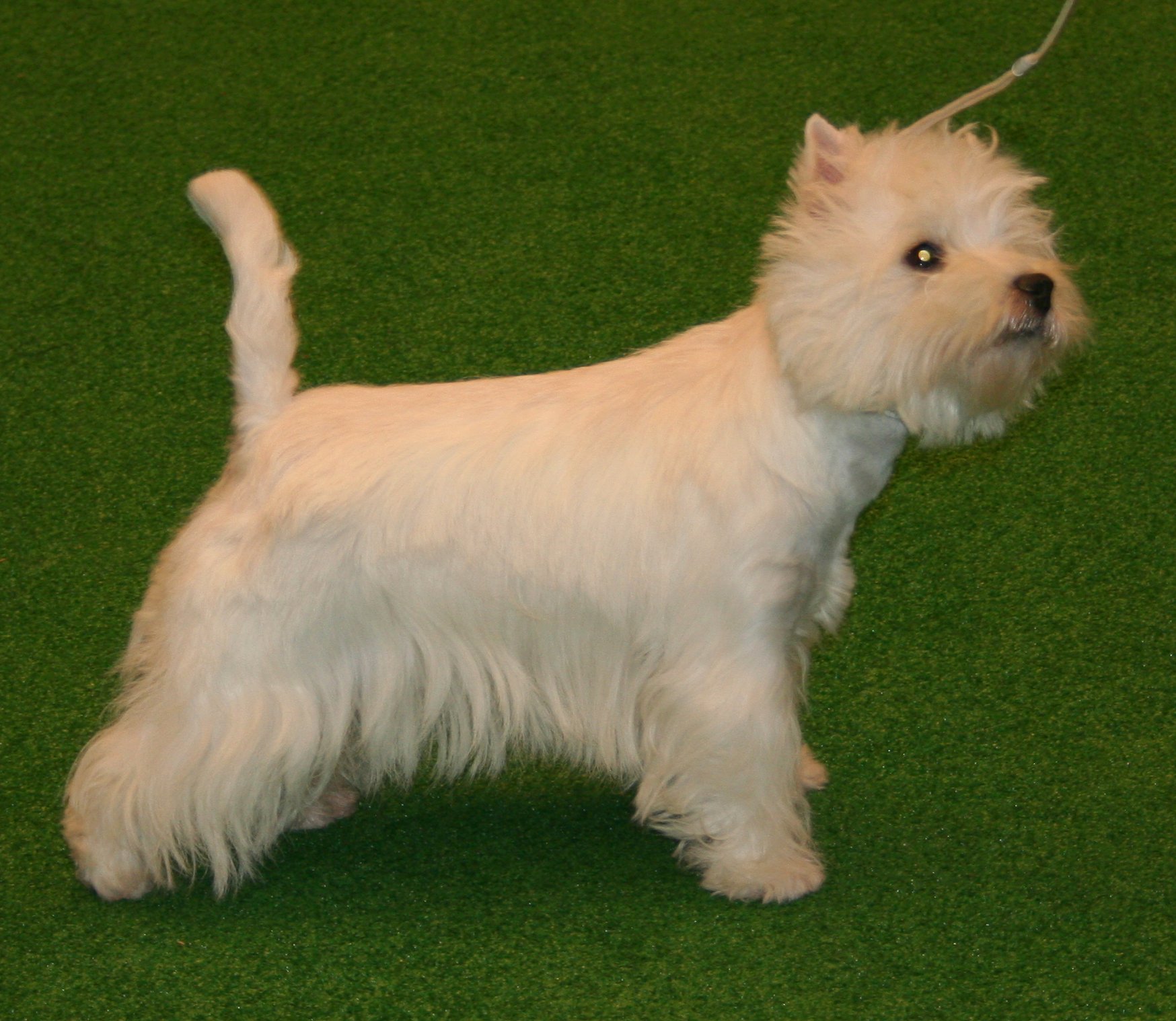
The West Highland White Terrier, affectionately known as the Westie, is a small but mighty breed.
Originating from Scotland, the West Highland White Terrier was first bred in the 18th century to hunt small game.
This feisty little dog has a rich history, with its original purpose being to flush out rodents and other small animals from burrows.
Westies are known for their friendly and outgoing personalities, making them great companions for families and individuals alike.
With their short, dense coats, Westies require regular grooming to prevent matting and tangling.
Expand your knowledge: Are Westies Hypoallergenic Dogs
Size and Appearance
The West Highland White Terrier is a sturdy little dog with a deep chest and a slightly rectangular shape. They're quite compact, but still pack a lot of personality.
Males are about 11 inches tall and typically weigh 15 to 22 pounds, while females are roughly 10 inches tall and weigh 13 to 16 pounds. That's quite a range, but they're all adorable in their own way.
Here are the key physical characteristics of the West Highland White Terrier:
- Ears: small, triangular, wide set, and erect
- Eyes: dark brown and almond-shaped with a lively, intelligent expression
- Nose: somewhat blunt with a large black nose
- Coat: double-coated with a hard, straight outer coat about two inches in length and a soft undercoat
- Coat Color: white
- Tail: compact, strong, and straight, often compared to a carrot
Size
The West Highland White Terrier is a sturdy little dog with a deep chest and a slightly rectangular shape.
Males can grow up to 11 inches tall.
Females are roughly 10 inches tall.
Males typically weigh between 15 to 22 pounds.
Females weigh between 13 to 16 pounds.
Westies can weigh more than the norm, especially if they have a charming owner who spoils them.
Appearance
The West Highland White Terrier is a breed that's hard to miss, thanks to their distinctive appearance. Their compact body is a key part of their charm.
One of the first things you'll notice about a Westie is their ears, which are small, triangular, and wide set. They're always erect, giving them a perky and alert look.
Their eyes are another standout feature, with dark brown almond shapes that seem to sparkle with intelligence. It's not uncommon to see a Westie's eyes lighting up with excitement when they sense something interesting.
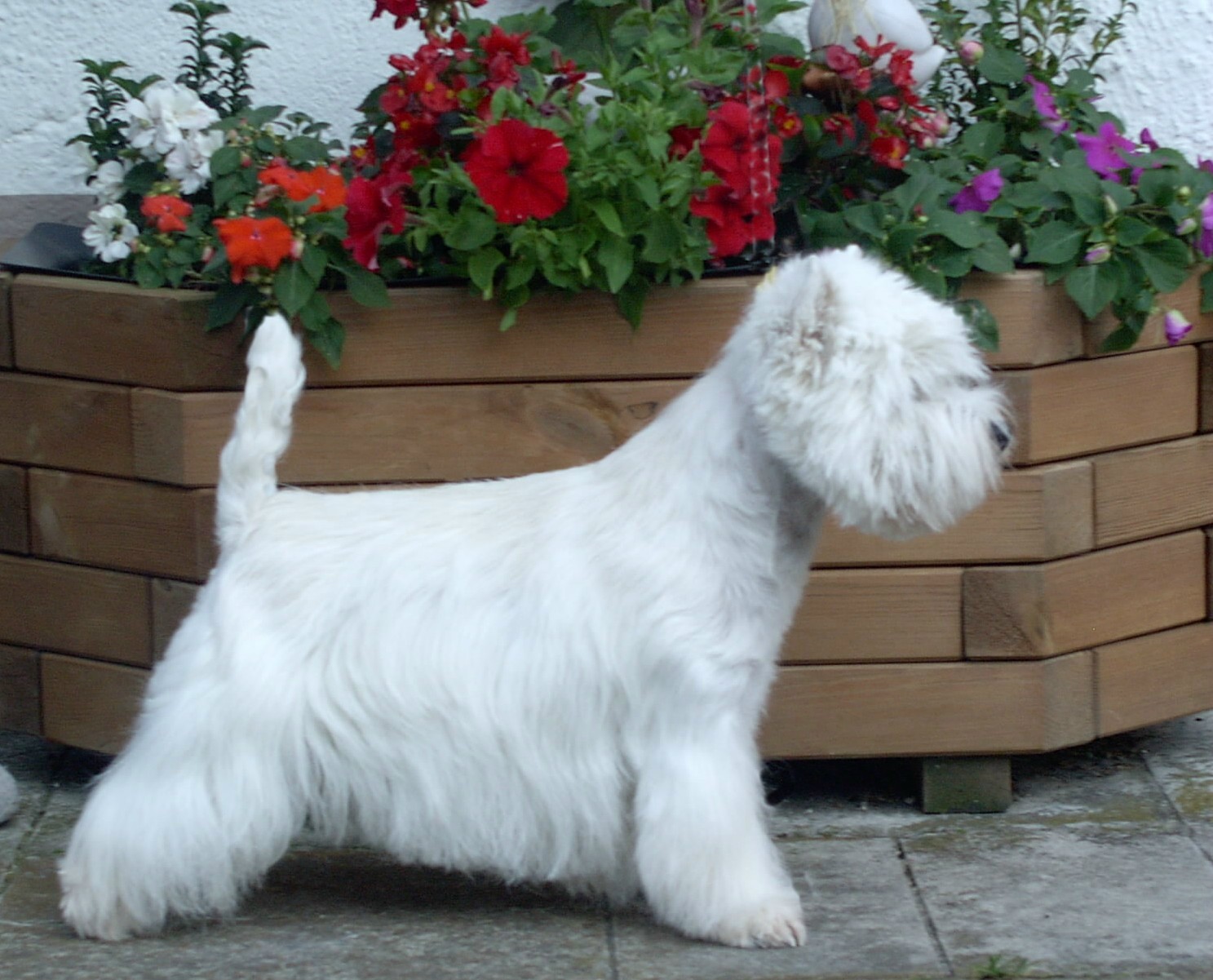
The Westie muzzle is somewhat blunt, with a large black nose that's always prominent. This, combined with their compact body, gives them a sturdy and robust appearance.
Westies have a double coat, with a hard, straight outer layer that's about two inches in length. This helps to protect them from the elements and keep them looking their best.
Of course, the most obvious thing about a Westie is their coat color – a pure white that's exactly as their name implies. It's a beautiful and distinctive look that's all their own.
Their tail is another notable feature, with a compact, strong shape that's often compared to a carrot. It's a great indicator of their lively and energetic personality.
Here are the key features of a Westie's appearance:
- Ears: small, triangular, wide set, and erect
- Eyes: dark brown, almond-shaped, with a lively and intelligent expression
- Nose: large black, prominent on a somewhat blunt muzzle
- Coat: double-coated, with a hard, straight outer layer and a soft undercoat
- Coat Color: white
- Tail: compact, strong, and straight, often compared to a carrot
Personality and Temperament
The West Highland White Terrier is a bold, confident, and fun-loving dog who finds joy in the simplest pleasures of life. They're known for their happy disposition and love of life, making them a favorite among many dog owners.
These dogs are friendly and get along with everyone, but they can be spunky and may not back down from a fight. They're not typically aggressive, but they won't walk away from a confrontation either. Same-sex aggression around other dogs is not rare, especially among females who tend to be more alpha.
Here are some key personality traits of the West Highland White Terrier:
They're intelligent and can be trained to a high level, but they can also be strong-willed at times. With proper socialization and training, they can get along well with other pets, but they may have a strong prey drive and chase small animals.
Personality and Temperament
The West Highland White Terrier is a bundle of energy and joy, with a personality that's hard to resist. They're bold, confident, and fun-loving, always up for an adventure.
Westies are intelligent dogs who thrive on attention and love to be the center of attention. They're outgoing and loyal, but also have a feisty, independent streak that can make them a bit stubborn at times.
One thing to keep in mind is that Westies can be prone to same-sex aggression around other dogs, especially females who tend to be more alpha. Males, on the other hand, are often more laid-back and happy-go-lucky.
Despite their small size, Westies are active dogs who need regular exercise to stay happy and healthy. They're natural-born hunters, with a strong prey drive that can send them chasing after smaller pets if they're not properly socialized.
Here are some key personality traits of the West Highland White Terrier:
Overall, the West Highland White Terrier is a lovable, lively companion who brings joy and energy to any family. With proper training and socialization, they can thrive in a variety of living situations, from apartments to homes with yards.
Children and Pets
Children and pets can be a great combination, but it's essential to consider the dog's temperament and energy level. If you have a West Highland White Terrier, it's crucial to supervise interactions between your dog and kids.
Westies are generally good with older children, but it's recommended that all children in the household be at least seven years old. This is because they can snap if annoyed, so proper supervision is key.
A Westie is also good with other dogs, but intact males may not get along with other intact male dogs. If you have multiple dogs, it's best to introduce them slowly and under close supervision.
If you have cats, a Westie can adjust to them, but it's easier if they're introduced at a young age. They have a strong prey drive, so it's best to keep small animals, like rabbits or birds, out of reach.
Remember, a Westie's instincts are to chase small animals, so it's not the best breed for households with small pets.
Take a look at this: When Is the Best Time to Breed a Dog
Health and Care
Regular grooming is essential to keep your Westie looking good. Brush and comb your dog's coat daily to avoid matting, which will keep it supple. This may sound like a lot of work, but once your dog gets used to it, it won't take much time - about a few minutes a day.
You should also trim your dog's coat every six to eight weeks, as they don't shed dead hair like some other breeds. This is why you need to help and thin out the hair by brushing and plucking out the old hair.
Westies have a hard coat, so too frequent bathing can do more harm than good. If you do need to bathe your Westie, use a mild dog shampoo and avoid using a machine to shear the coat - instead, trim it by hand with scissors. The coat shouldn't be too short afterwards.
Your Westie's claws need to be trimmed from time to time if they don't wear off on their own, and should be kept about two millimeters from the ground. You should also check the paws or pads for foreign bodies after every walk.
Regular dental care is also important for your Westie. Brush their teeth regularly using special toothpaste for dogs, which will help prevent problems with inflammation or tartar.
Care and Feeding
Crate training is a kind and effective way to ensure your Westie doesn't have accidents in the house or get into things they shouldn't. A crate can also provide a quiet space for your dog to rest.
Your Westie's diet consists of 1/2 to 1.5 cups of high-quality dry food per day, divided into two meals. The quality of dog food matters, and a better food will go further in nourishing your dog.
Regular grooming is essential to keep your Westie looking good, and it's best to start grooming your puppy so they get used to it. Brushing and trimming are crucial to prevent matting and shedding, and you should do it every day for a few minutes.
Recommended read: Boston Terrier Day
Nutrition and Feeding
Small dogs like West Highland White Terriers have a fast metabolism, meaning they burn energy at a high rate.
Their small stomachs mean they must eat little and often, which is why small-breed foods are designed with smaller kibble sizes to suit smaller mouths.
This also encourages chewing and improves digestion, making it easier for your Westie to get the nutrients they need.
A highly active dog will need more food than a couch potato dog, so it's essential to consider your dog's activity level when determining their daily ration.
For Westies, the recommended daily amount is 1/2 to 1.5 cups of high-quality dry food, divided into two meals.
The quality of dog food you buy also makes a difference - the better the food, the less of it you'll need to feed your dog.
You should follow the manufacturer's recommendations for the amount of food, and always discuss the amount and type of food with your vet to ensure it's suitable for your individual dog.
Treats should only be fed in moderation and deducted from the basic diet to avoid obesity.
For puppies, it's typical to feed 4-6 times a day, which should be gradually reduced to 2 meals per day until they're fully grown.
Older dogs need less fat and protein than growing puppies, and fewer calories, too!
Readers also liked: Will Shiba Inu Reach 1 Cent
Suitable Accessories
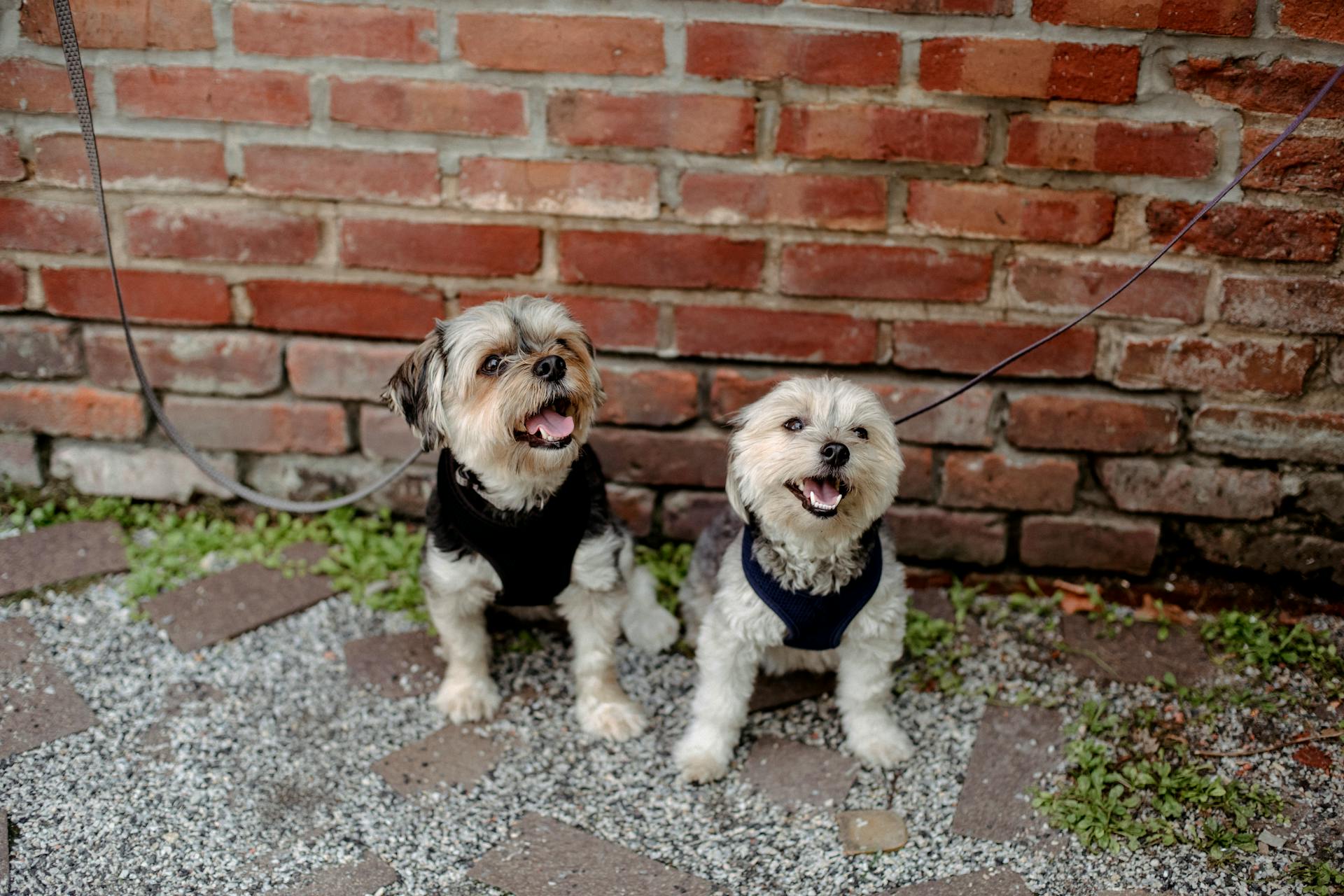
A West Highland White Terrier's grooming needs are a must. You'll need a brush and comb to brush and comb their coat, and scissors to cut their hair.
You should also get a pair of claw clippers and special toothpaste for dogs. This will help keep them clean and well-groomed.
Dog toys are a great way to keep your Westie entertained and stimulated. Variety is key, so consider getting toys for running and romping, or ones that challenge their intelligence.
A toy that promotes intelligence, such as one with hidden compartments, is a great idea. This will keep them engaged and active.
When choosing a lead, collar, or harness, make sure it's the right size for your Westie. This will ensure their comfort and safety.
A cozy dog mat or basket with a blanket can provide a sense of security and comfort for your Westie. A transport box for car rides is also a good idea.
You'll need a food and water bowl, a mild dog shampoo, and a first aid kit. Be sure to check with your vet for recommendations on what to include in the first aid kit.
Intriguing read: Shiba Inu 1 Dollar
How to Care
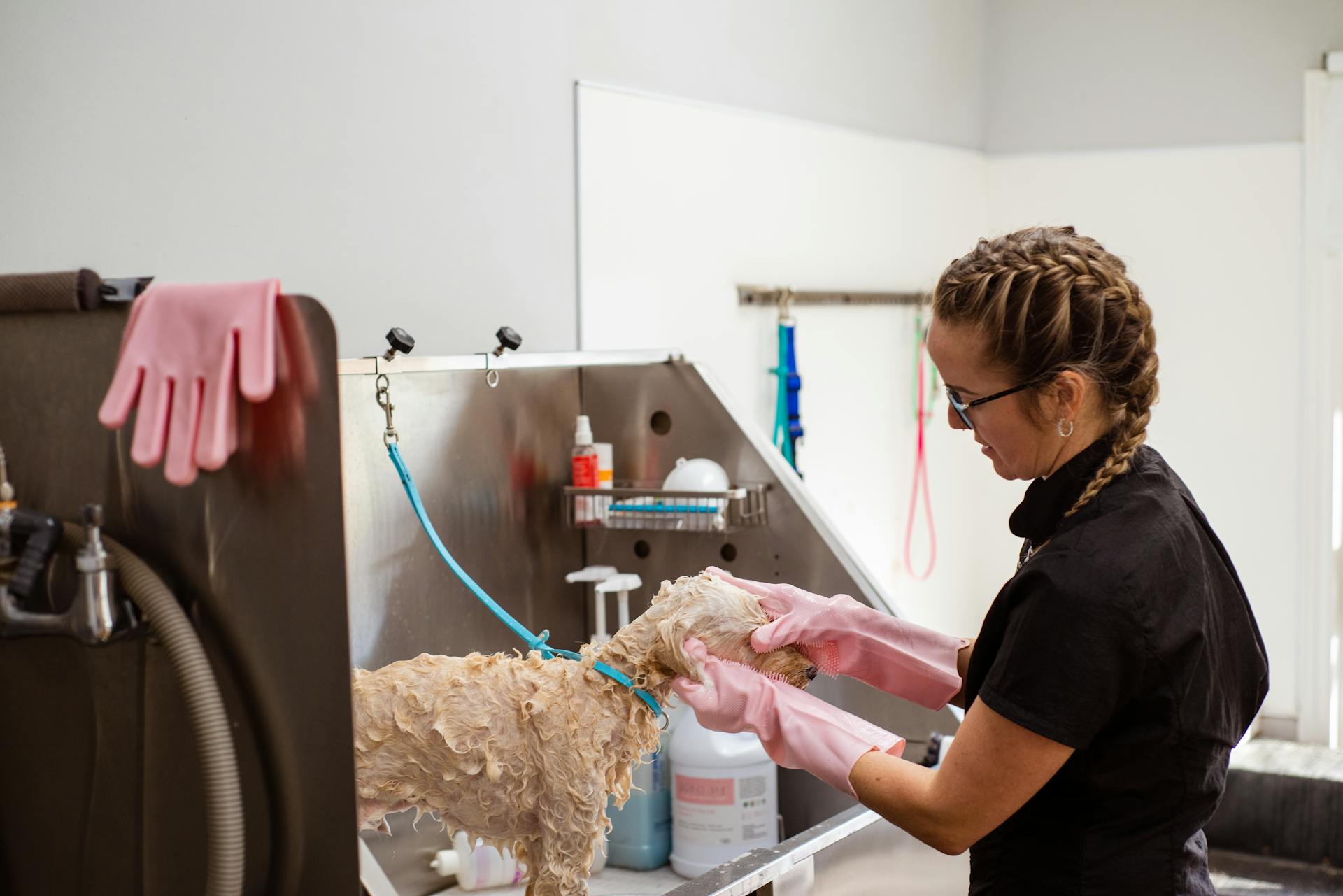
Crate training is a kind way to ensure your Westie doesn't have accidents in the house or get into things he shouldn't. A crate is also a place where he can retreat for a nap.
Your Westie needs regular grooming to keep him looking good. Brush and comb his coat daily to avoid matting, which will keep it supple. This will take only a few minutes a day.
Westies have a hard coat, so too frequent bathing can do more harm than good. Use a mild dog shampoo when bathing, and only do so when necessary.
Your Westie's claws need to be trimmed from time to time if they don't wear off on their own. They should be kept about two millimeters from the ground.
Fresh water should always be accessible for your Westie. Feed a high-quality canine diet with balanced nutrition, and discuss the amount and type of food with your vet to ensure it's suitable for your individual dog.
Suggestion: When Should You Breed a Female Dog
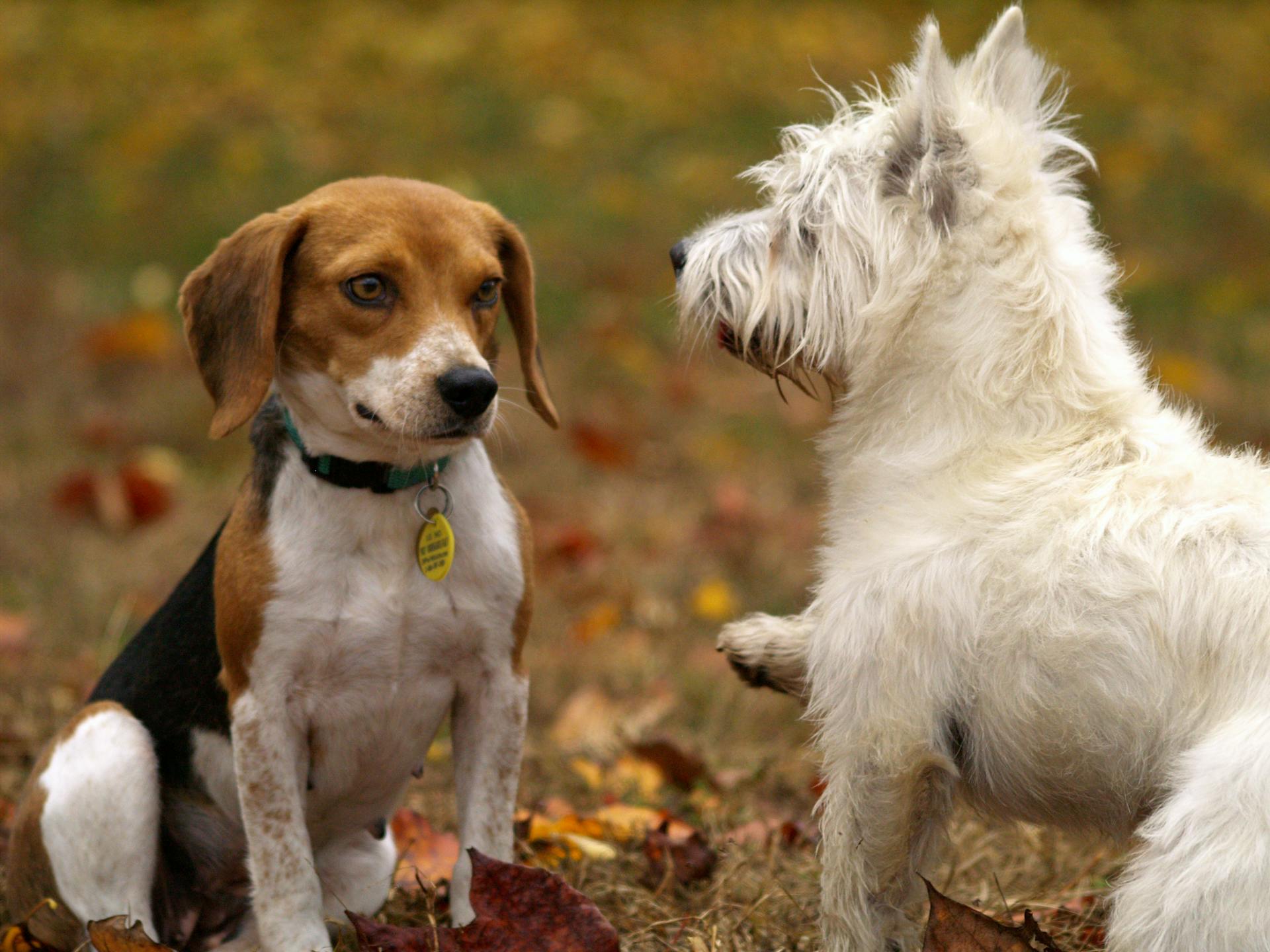
To prevent overeating, monitor treats and other extra food. A good rule of thumb is to feed two measured meals per day.
A Westie's diet should be nutritionally complete and balanced, and meet Association of American Feed Control Officials (AAFCO) standards. Select a food that's appropriate for their age, weight, and activity level.
Your Westie's daily caloric intake should be carefully considered, including dog treats. Consult your veterinarian for guidance on choosing the right food and feeding plan.
To keep your Westie stimulated, engage their brains with new tricks and games. Leave puzzle toys around the house for them to solve, and reward them with yummy treats.
A good accessory for a Westie is a toy that promotes intelligence, such as hiding food or treats in different compartments.
See what others are reading: Good Dog Treats for Yorkies
Frequently Asked Questions
Do West Highland white terriers bark a lot?
Yes, West Highland White Terriers (Westies) are known to bark frequently. Their barking habits can be influenced by their environment and upbringing.
Is a Westie a good family dog?
Westies are a great choice for families due to their gentle nature and affection for children when well-trained. They make excellent small dogs for families who want a loving and loyal companion.
How much is a West Highland White Terrier?
A West Highland White Terrier can cost between $1,200 to $2,500 from a reputable breeder, depending on the pedigree and location. Be sure to research trustworthy breeders to avoid overpriced or scam listings.
Do Westies like to cuddle?
Westies are affectionate and love to cuddle with their family. They make great companions for those who enjoy snuggles and playtime.
Sources
- https://dogtime.com/dog-breeds/west-highland-white-terrier
- https://be.chewy.com/dog-breed/west-highland-white-terrier/
- https://www.hundeo.com/en/dog-breeds/west-highland-white-terrier/
- https://www.purina.co.nz/find-a-pet/dog-breeds/west-highland-white-terrier
- https://www.thesprucepets.com/west-highland-white-terrier-breed-profile-1118007
Featured Images: pexels.com
